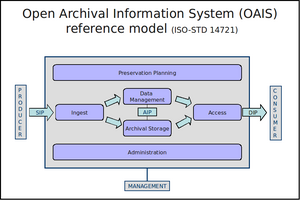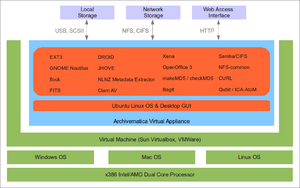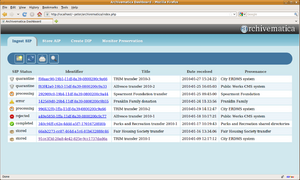Overview
Main Page > Documentation > Overview
Open Source OAISThe Archivematica project is integrating a number of open-source tools to create a comprehensive digital archives system that is compliant with the ISO-OAIS functional model and other digital preservation standards and best practices. All of the Archivematica code and documentation is re-released under GPL and Creative Commons open-source licenses. Virtualization technologyUsing the latest in virtualization technology, each release of the system is packaged as a virtual appliance, making it possible to run on any consumer-grade hardware and operating system, even directly from a USB key. This means an entire suite of digital preservation tools is now available to the average archivist from one simple installation. At the same time, the Archivematica architecture allows it to be componentized and installed on enterprise-scale hardware in a distributed architecture to support large-scale, resource-intensive production environments. Media type preservation plansArchivematica does not prescribe a specific SIP format, essentially accepting files for ingest with as much or as little metadata as is available. It runs the SIP through standard quarantine, identification, validation, metadata extraction and normalisation processes using a variety of tools such as FITS, Xena and Clam AV. Archivematica maintains the original format of all ingested files to support migration and emulation preservation strategies. Archivematica's primary preservation strategy is to normalize files to preservation and access formats upon ingest. Archivematica assigns each file format to a media type preservation plan. The choice of access formats is based on the ubiquity of viewers for the file format. Archivematica's preservation formats are all open standards. Additionally, the choice of preservation format is based on community best practices, availability of open-source normalization tools, and an analysis of the significant properties for each media type. Open storage and access architectureArchivematica packages AIPs using PREMIS, METS and Library of Congress’ Bagit format. The Archivematica virtual appliance is able to interact with any number of networked or external storage devices to allow for the flexible implementation of an archival storage and backup strategy, which can range from using a simple filesystem to sophisticated vendor storage arrays. It then prepares DIP access derivatives and sends these to a web-based application such as ICA-AtoM or Archon for further enhancement of descriptive metadata, integration into existing institutional archival descriptions and public access. All of the Archivematica workflows are tracked via the web-based Archivematica Dashboard. Lowering the barrier to best-practice digital preservationThe project goal is to give archivists with limited technical and financial capacity the tools, methodology and confidence to begin preserving digital information today. The project has conducted a thorough OAIS use case and process analysis to synthesize the specific, concrete steps that must be carried out to comply with the OAIS functional model from Ingest to Access. Wherever possible, these steps are assigned to software tools within the Archivematica system. If it is not possible to automate these steps in the current system iteration, they are incorporated and documented into a manual procedure to be carried out by the end user. This ensures that the entire set of preservation requirements is being carried out, even in the very early iterations of the system. In short, the system is conceptualized as an integrated whole of technology, people and procedures, not just a set of software tools. All of the software, documentation and development infrastructure are available free of charge and released under GPL and Creative Commons licenses to give users the freedom to study, adapt and re-distribute these resources as best suits them. Rather than spend precious funding on proprietary software licenses that restrict these freedoms, the Archivematica project encourages memory institutions tackling the challenges of digital preservation to pool their financial and technical resources in projects like Archivematica to maximize their long-term investments for the benefit of their colleagues, users and professional community as a whole. |
|


